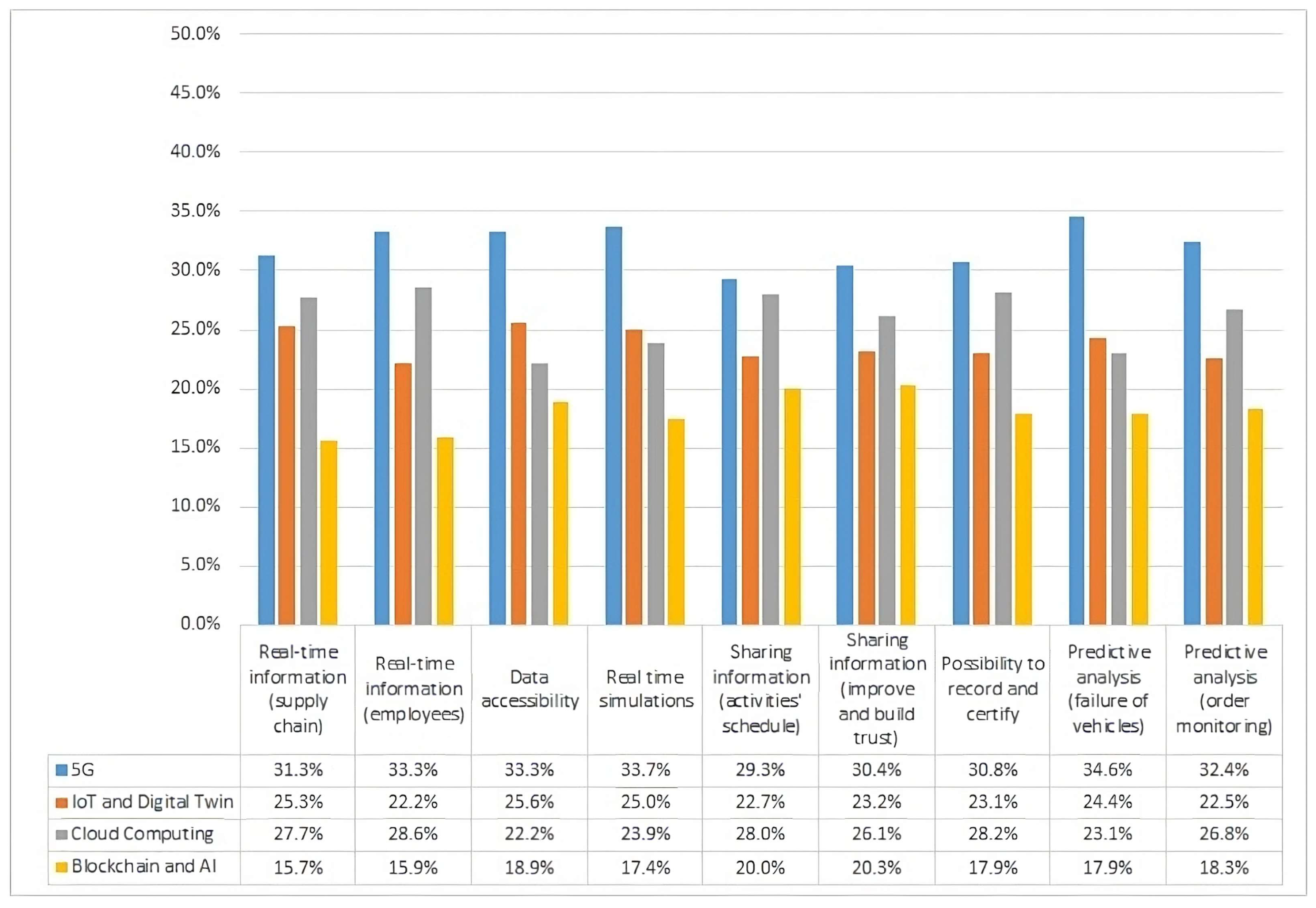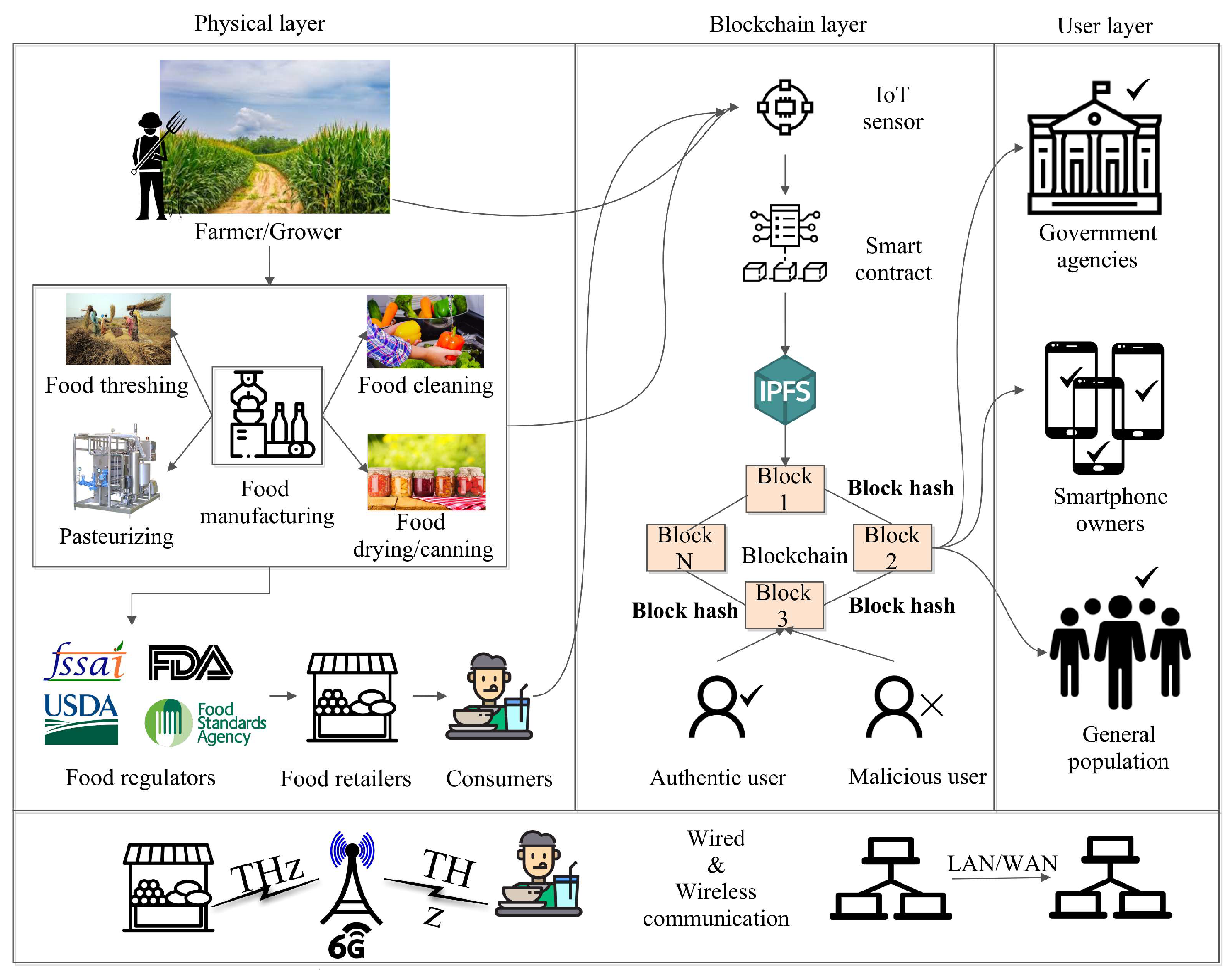Submitted:
18 September 2024
Posted:
19 September 2024
You are already at the latest version
Abstract
Keywords:
Introduction

Keyword Selection
Journal Selection And Inclusion/Exclusion Criteria

Descriptive Findings

Understanding Block Chain Technology in Agriculture
Enhancing Food Supply Chain Transparency through Blockchain

 |
Traceability in Agriculture: The Role of Blockchain

The Impact of Blockchain on Farm-to-Fork Transparency

Revolutionizing Food Safety with Blockchain Solutions

Blockchain Applications: Streamlining Agricultural Operations

Building Trust in Food Sources with Blockchain Technology
The Future of Agriculture: Blockchain-Enabled Supply Chains

Overcoming Challenges in Agricultural Traceability with Blockchain
Transparency and Accountability
Data Integrity
Decentralization
Real-time Visibility
Smart Contracts:
Conclusions
References
- Apruzzese, M., Bruni, M. E., Musso, S., & Perboli, G. (2023). 5G and companion technologies as a boost in new business models for logistics and supply chain. Sustainability, 15(15), 11846.
- Cao, S., Powell, W., Foth, M., Natanelov, V., Miller, T., & Dulleck, U. (2021). Strengthening consumer trust in beef supply chain traceability with a blockchain-based human-machine reconcile mechanism. Computers and Electronics in Agriculture, 180, 105886.
- Chandan, A., John, M., & Potdar, V. (2023). Achieving UN SDGs in Food Supply Chain Using Blockchain Technology. Sustainability, 15(3), 2109.
- Chang, S. E., Chen, Y.-C., & Lu, M.-F. (2019). Supply chain re-engineering using blockchain technology: A case of smart contract based tracking process. Technological Forecasting and Social Change, 144, 1-11.
- Choi, T.-M., Feng, L., & Li, R. (2020). Information disclosure structure in supply chains with rental service platforms in the blockchain technology era. International Journal of Production Economics, 221, 107473.
- Collart, A. J., & Canales, E. (2022). How might broad adoption of blockchain-based traceability impact the US fresh produce supply chain? Applied Economic Perspectives and Policy, 44(1), 219-236.
- Demestichas, K., & Daskalakis, E. (2020). Information and communication technology solutions for the circular economy. Sustainability, 12(18), 7272.
- Demestichas, K., Peppes, N., Alexakis, T., & Adamopoulou, E. (2020). Blockchain in agriculture traceability systems: A review. Applied Sciences, 10(12), 4113.
- Ding, H., Sun, Y., Huang, N., Shen, Z., Wang, Z., Iftekhar, A., & Cui, X. (2023). RVGAN-TL: A generative adversarial networks and transfer learning-based hybrid approach for imbalanced data classification. Information Sciences, 629, 184-203.
- Duan, J., Zhang, C., Gong, Y., Brown, S., & Li, Z. (2020). A content-analysis based literature review in blockchain adoption within food supply chain. International journal of environmental research and public health, 17(5), 1784.
- Ellahi, R. M., Wood, L. C., & Bekhit, A. E.-D. A. (2023). Blockchain-based frameworks for food traceability: a systematic review. Foods, 12(16), 3026.
- Feng, H., Wang, X., Duan, Y., Zhang, J., & Zhang, X. (2020). Applying blockchain technology to improve agri-food traceability: A review of development methods, benefits and challenges. Journal of Cleaner Production, 260, 121031.
- Feng, J., Yu, F. R., Pei, Q., Chu, X., Du, J., & Zhu, L. (2019). Cooperative computation offloading and resource allocation for blockchain-enabled mobile-edge computing: A deep reinforcement learning approach. IEEE Internet of Things Journal, 7(7), 6214-6228.
- Francisco, K., & Swanson, D. (2018). The supply chain has no clothes: Technology adoption of blockchain for supply chain transparency. Logistics, 2(1), 2.
- Guido, R., Mirabelli, G., Palermo, E., & Solina, V. (2020). A framework for food traceability: case study--Italian extra-virgin olive oil supply chain. International Journal of Industrial Engineering & Management (IJIEM), 11(1).
- Hasanova, H., Baek, U. j., Shin, M. g., Cho, K., & Kim, M. S. (2019). A survey on blockchain cybersecurity vulnerabilities and possible countermeasures. International Journal of Network Management, 29(2), e2060.
- Kawaguchi, N. (2019). Application of blockchain to supply chain: Flexible blockchain technology. Procedia Computer Science, 164, 143-148.
- Khan, H. H., Malik, M. N., Konečná, Z., Chofreh, A. G., Goni, F. A., & Klemeš, J. J. (2022). Blockchain technology for agricultural supply chains during the COVID-19 pandemic: Benefits and cleaner solutions. Journal of Cleaner Production, 347, 131268.
- Kouhizadeh, M., & Sarkis, J. (2018). Blockchain practices, potentials, and perspectives in greening supply chains. Sustainability, 10(10), 3652.
- Lin, S.-Y., Zhang, L., Li, J., Ji, L.-l., & Sun, Y. (2022). A survey of application research based on blockchain smart contract. Wireless Networks, 28(2), 635-690.
- Liu, C. H., Lin, Q., & Wen, S. (2018). Blockchain-enabled data collection and sharing for industrial IoT with deep reinforcement learning. IEEE Transactions on Industrial Informatics, 15(6), 3516-3526.
- Makhdoom, I., Abolhasan, M., Abbas, H., & Ni, W. (2019). Blockchain's adoption in IoT: The challenges, and a way forward. Journal of Network and Computer Applications, 125, 251-279.
- Mirabelli, G., & Solina, V. (2020). Blockchain and agricultural supply chains traceability: Research trends and future challenges. Procedia Manufacturing, 42, 414-421.
- Mohsin, A. H., Zaidan, A., Zaidan, B., Albahri, O. S., Albahri, A. S., Alsalem, M., & Mohammed, K. (2019). Blockchain authentication of network applications: Taxonomy, classification, capabilities, open challenges, motivations, recommendations and future directions. Computer Standards & Interfaces, 64, 41-60.
- Omar, I. A., Jayaraman, R., Debe, M. S., Salah, K., Yaqoob, I., & Omar, M. (2021). Automating procurement contracts in the healthcare supply chain using blockchain smart contracts. Ieee Access, 9, 37397-37409.
- Pawar, A., Jawale, M., William, P., Chhabra, G., Rakshe, D. S., Korde, S. K., & Marriwala, N. (2022). Implementation of blockchain technology using extended CNN for lung cancer prediction. Measurement: Sensors, 24, 100530.
- Probst, W. N. (2020). How emerging data technologies can increase trust and transparency in fisheries. ICES Journal of Marine Science, 77(4), 1286-1294.
- Rejeb, A., Keogh, J. G., & Treiblmaier, H. (2019). Leveraging the internet of things and blockchain technology in supply chain management. Future Internet, 11(7), 161.
- Rejeb, A., Keogh, J. G., Zailani, S., Treiblmaier, H., & Rejeb, K. (2020). Blockchain technology in the food industry: A review of potentials, challenges and future research directions. Logistics, 4(4), 27.
- Salah, K., Nizamuddin, N., Jayaraman, R., & Omar, M. (2019). Blockchain-based soybean traceability in agricultural supply chain. Ieee Access, 7, 73295-73305.
- Sharma, B., & Koundal, D. (2018). Cattle health monitoring system using wireless sensor network: a survey from innovation perspective. IET Wireless Sensor Systems, 8(4), 143-151.
- Sharma, P., Jindal, R., & Borah, M. D. (2023). A review of smart contract-based platforms, applications, and challenges. Cluster Computing, 26(1), 395-421.
- Srivastava, A., Jawaid, S., Singh, R., Gehlot, A., Akram, S. V., Priyadarshi, N., & Khan, B. (2022). Imperative role of technology intervention and implementation for automation in the construction industry. Advances in Civil Engineering, 2022.
- Sugandh, U., Nigam, S., Khari, M., & Misra, S. (2023). An Approach for Risk Traceability Using Blockchain Technology for Tracking, Tracing, and Authenticating Food Products. Information, 14(11), 613.
- Treiblmaier, H., Rejeb, A., & Strebinger, A. (2020). Blockchain as a driver for smart city development: application fields and a comprehensive research agenda. Smart Cities, 3(3), 853-872.
- Tsoukas, V., Gkogkidis, A., Kampa, A., Spathoulas, G., & Kakarountas, A. (2022). Enhancing food supply chain security through the use of blockchain and TinyML. Information, 13(5), 213.
- Vu, T. T., & Trinh, H. H. H. (2021). Blockchain technology for sustainable supply chains of agri-food in Vietnam: a SWOT analysis. Science & Technology Development Journal: Economics-Law & Management, 5(1), 1278-1289.
- Wang, R., Lin, Z., & Luo, H. (2019). Blockchain, bank credit and SME financing. Quality & Quantity, 53, 1127-1140.
- Xu, X., Weber, I., Staples, M., Xu, X., Weber, I., & Staples, M. (2019). Case study: AgriDigital: Blockchain technology in the trade and finance of agriculture supply chains. Architecture for blockchain applications, 239-255.
- Yadav, V. S., & Singh, A. (2019). A systematic literature review of blockchain technology in agriculture. Proceedings of the international conference on industrial engineering and operations management,.
- Zhao, G., Liu, S., Lopez, C., Lu, H., Elgueta, S., Chen, H., & Boshkoska, B. M. (2019). Blockchain technology in agri-food value chain management: A synthesis of applications, challenges and future research directions. Computers in industry, 109, 83-99.
- Zhao, Y., Zhao, J., Jiang, L., Tan, R., Niyato, D., Li, Z., Lyu, L., & Liu, Y. (2020). Privacy-preserving blockchain-based federated learning for IoT devices. IEEE Internet of Things Journal, 8(3), 1817-1829.
- Apruzzese, M., Bruni, M. E., Musso, S., & Perboli, G. (2023). 5G and companion technologies as a boost in new business models for logistics and supply chain. Sustainability, 15(15), 11846.
- Goyal, K., & Kumar, S. (2021). Financial literacy: A systematic review and bibliometric analysis. International Journal of Consumer Studies, 45(1), 80-105.
- Li, C., Yang, T., & Shi, Y. (2023). Blockchain Adoption and Organic Subsidy in an Agricultural Supply Chain Considering Market Segmentation. Mathematics, 12(1), 106.
- Nanda, A. P., & Banerjee, R. (2021). Consumer’s subjective financial well-being: A systematic review and research agenda. International Journal of Consumer Studies, 45(4), 750-776.
- Shi, W., Pallis, G., & Xu, Z. (2019). Edge computing [scanning the issue]. Proceedings of the IEEE, 107(8), 1474-1481.
- Talwar, S., Talwar, M., Kaur, P., & Dhir, A. (2020). Consumers’ resistance to digital innovations: A systematic review and framework development. Australasian Marketing Journal (AMJ), 28(4), 286-299.
- Tanwar, S., Parmar, A., Kumari, A., Jadav, N. K., Hong, W.-C., & Sharma, R. (2022). Blockchain adoption to secure the food industry: Opportunities and challenges. Sustainability, 14(12), 7036.
- Zhang, T., Jia, F., & Chen, L. (2024). Blockchain adoption in supply chains: implications for sustainability. Production Planning & Control, 1-24.
Disclaimer/Publisher’s Note: The statements, opinions and data contained in all publications are solely those of the individual author(s) and contributor(s) and not of MDPI and/or the editor(s). MDPI and/or the editor(s) disclaim responsibility for any injury to people or property resulting from any ideas, methods, instructions or products referred to in the content. |
© 2024 by the authors. Licensee MDPI, Basel, Switzerland. This article is an open access article distributed under the terms and conditions of the Creative Commons Attribution (CC BY) license (http://creativecommons.org/licenses/by/4.0/).





